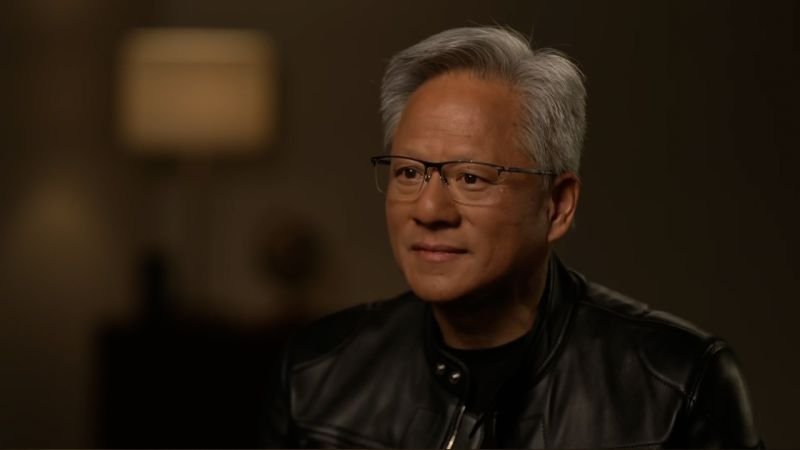CNN
—
America’s plan to “re-industrialize” technology manufacturing is “exactly the right thing,” said Jensen Huang, CEO of the world’s leading AI chipmaker.
In an interview with CNN’s Fareed Zakaria, Huang, who heads the Santa Clara, California-based Nvidia, said the United States should invest in manufacturing and is currently “missing that entire band in our industries.”
“That passion, the skill, the craft of making things; the ability to make things is valuable for economic growth — it’s value for a stable society with people who can create a wonderful life and a wonderful career without having to get a PhD in physics,” Huang said.
The Trump administration has instituted a slew of policies, including sweeping tariffs, in an effort to revive America’s declining manufacturing industries. It has been in part to boost the automotive and energy sectors, as well as investments in technologies.
“President Trump has made it clear America cannot rely on China to manufacture critical technologies such as semiconductors, chips, smartphones, and laptops,” White House press secretary Karoline Leavitt said in a statement in April after a temporary tariff pause was instituted on smartphones and other electronics.
Huang said that onshoring manufacturing would take the pressure off of Taiwan, where the world’s largest semiconductor maker, Taiwan Semiconductor Manufacturing Company (TSMC), is based. Trump announced in March that the chipmaking giant would invest at least $100 billion in US manufacturing.
“Having a rich ecosystem of industries and manufacturing so that we could, on the one hand, make the United States better but also reduce our dependency — sole dependency — on other countries, is a smart move,” Huang said.
The increase in AI investments, which fueled a massive technology boom in recent years, has raised concerns about whether the technology will threaten jobs in the future. A survey released in January from the World Economic Forum showed 41% of employers plan to downsize their workforce by 2030 because of AI automation.
Nvidia, which briefly reached $4 trillion in market value, has created technology to power data centers that companies like Microsoft, Amazon and Google use to operate their AI models and cloud services.
“Everybody’s jobs will be affected. Some jobs will be lost. Many jobs will be created and what I hope is that the productivity gains that we see in all the industries will lift society,” Huang said.
He explained that every software engineer and chip designer at Nvidia uses AI, and he encourages it “to the point of mandating it.”
Artificial intelligence tools, especially generative response platforms like Elon Musk’s Grok and OpenAI’s ChatGPT, have faced their fair share of controversies recently.
Just last week, Grok began responding with posts after Musk’s xAI tweaked the chatbot to allow it to offer users more “politically incorrect” answers. It began creating antisemitic hate posts, among other graphic descriptions.
xAI posted a statement Saturday that an update of “deprecated code” made Grok susceptible to existing user posts on X, including extremist views. That code has since been removed, according to the X statement.
Huang commented on Grok, saying it’s probably because the chatbot is “younger” but that Musk “has made so much progress with Grok in 18 months.”
“Of course there’s the fine tuning, there’s the guardrailing, and that just takes time of polish,” he said.
There have also been concerns about AI models being prone to “hallucinations,” meaning AI models go off-script and spew inaccurate information. Similarly, because they can be susceptible to manipulation, some experts have expressed concerns about losing control of powerful AI models.
But Huang believes that “borderline scares people” who do not know how AI systems are interconnected to keep the technology safe. He explained that most AI models use other AI tools to provide resources and fact-check. He added that global standards and safety practices should be in place.
“It will be overwhelmingly positive. Some harm will be done. The world has to jump on top of it when it happens, but it will be overwhelmingly, incredibly powerful,” he said.
Using AI in healthcare and real-world use
Huang said AI models could be used to cure diseases by teaching the tools about proteins and chemicals, including the meanings of chemicals and how they interact.
It would be similar to the process of drug discovery, but it’s more complicated than teaching AI about language because of the data required, Huang noted.
“Not only will we accelerate the discovery of drugs, we’ll improve our understanding of disease. But over time, we’re going to have virtual assistant researchers and scientists to help us essentially cure all disease,” he said. “I think that day is coming.”
There will also be real-world, physical use cases of AI. Generative models today, like Google’s Veo 3, can generate videos of physical actions. The next step is creating a robot that can complete similar tasks, like picking up a glass. That process would be a vision-language-action (VLA) model, which differs from large-language models (LLMs).
“The technology exists today. It works today,” Huang said, adding there will be lots of the technology in “three to five years.”























